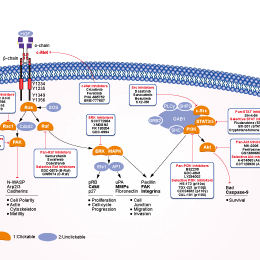
- Bioactive Compounds
- By Signaling Pathways
- PI3K/Akt/mTOR
- Epigenetics
- Methylation
- Immunology & Inflammation
- Protein Tyrosine Kinase
- Angiogenesis
- Apoptosis
- Autophagy
- ER stress & UPR
- JAK/STAT
- MAPK
- Cytoskeletal Signaling
- Cell Cycle
- TGF-beta/Smad
- DNA Damage/DNA Repair
- Compound Libraries
- Popular Compound Libraries
- Customize Library
- Clinical and FDA-approved Related
- Bioactive Compound Libraries
- Inhibitor Related
- Natural Product Related
- Metabolism Related
- Cell Death Related
- By Signaling Pathway
- By Disease
- Anti-infection and Antiviral Related
- Neuronal and Immunology Related
- Fragment and Covalent Related
- FDA-approved Drug Library
- FDA-approved & Passed Phase I Drug Library
- Preclinical/Clinical Compound Library
- Bioactive Compound Library-I
- Bioactive Compound Library-Ⅱ
- Kinase Inhibitor Library
- Express-Pick Library
- Natural Product Library
- Human Endogenous Metabolite Compound Library
- Alkaloid Compound LibraryNew
- Angiogenesis Related compound Library
- Anti-Aging Compound Library
- Anti-alzheimer Disease Compound Library
- Antibiotics compound Library
- Anti-cancer Compound Library
- Anti-cancer Compound Library-Ⅱ
- Anti-cancer Metabolism Compound Library
- Anti-Cardiovascular Disease Compound Library
- Anti-diabetic Compound Library
- Anti-infection Compound Library
- Antioxidant Compound Library
- Anti-parasitic Compound Library
- Antiviral Compound Library
- Apoptosis Compound Library
- Autophagy Compound Library
- Calcium Channel Blocker LibraryNew
- Cambridge Cancer Compound Library
- Carbohydrate Metabolism Compound LibraryNew
- Cell Cycle compound library
- CNS-Penetrant Compound Library
- Covalent Inhibitor Library
- Cytokine Inhibitor LibraryNew
- Cytoskeletal Signaling Pathway Compound Library
- DNA Damage/DNA Repair compound Library
- Drug-like Compound Library
- Endoplasmic Reticulum Stress Compound Library
- Epigenetics Compound Library
- Exosome Secretion Related Compound LibraryNew
- FDA-approved Anticancer Drug LibraryNew
- Ferroptosis Compound Library
- Flavonoid Compound Library
- Fragment Library
- Glutamine Metabolism Compound Library
- Glycolysis Compound Library
- GPCR Compound Library
- Gut Microbial Metabolite Library
- HIF-1 Signaling Pathway Compound Library
- Highly Selective Inhibitor Library
- Histone modification compound library
- HTS Library for Drug Discovery
- Human Hormone Related Compound LibraryNew
- Human Transcription Factor Compound LibraryNew
- Immunology/Inflammation Compound Library
- Inhibitor Library
- Ion Channel Ligand Library
- JAK/STAT compound library
- Lipid Metabolism Compound LibraryNew
- Macrocyclic Compound Library
- MAPK Inhibitor Library
- Medicine Food Homology Compound Library
- Metabolism Compound Library
- Methylation Compound Library
- Mouse Metabolite Compound LibraryNew
- Natural Organic Compound Library
- Neuronal Signaling Compound Library
- NF-κB Signaling Compound Library
- Nucleoside Analogue Library
- Obesity Compound Library
- Oxidative Stress Compound LibraryNew
- Plant Extract Library
- Phenotypic Screening Library
- PI3K/Akt Inhibitor Library
- Protease Inhibitor Library
- Protein-protein Interaction Inhibitor Library
- Pyroptosis Compound Library
- Small Molecule Immuno-Oncology Compound Library
- Mitochondria-Targeted Compound LibraryNew
- Stem Cell Differentiation Compound LibraryNew
- Stem Cell Signaling Compound Library
- Natural Phenol Compound LibraryNew
- Natural Terpenoid Compound LibraryNew
- TGF-beta/Smad compound library
- Traditional Chinese Medicine Library
- Tyrosine Kinase Inhibitor Library
- Ubiquitination Compound Library
-
Cherry Picking
You can personalize your library with chemicals from within Selleck's inventory. Build the right library for your research endeavors by choosing from compounds in all of our available libraries.
Please contact us at info@selleckchem.com to customize your library.
You could select:
- Antibodies
- Bioreagents
- qPCR
- 2x SYBR Green qPCR Master Mix
- 2x SYBR Green qPCR Master Mix(Low ROX)
- 2x SYBR Green qPCR Master Mix(High ROX)
- Protein Assay
- Protein A/G Magnetic Beads for IP
- Anti-Flag magnetic beads
- Anti-Flag Affinity Gel
- Anti-Myc magnetic beads
- Anti-HA magnetic beads
- Poly DYKDDDDK Tag Peptide lyophilized powder
- Protease Inhibitor Cocktail
- Protease Inhibitor Cocktail (EDTA-Free, 100X in DMSO)
- Phosphatase Inhibitor Cocktail (2 Tubes, 100X)
- Cell Biology
- Cell Counting Kit-8 (CCK-8)
- Animal Experiment
- Mouse Direct PCR Kit (For Genotyping)
- New Products
- Contact Us
research use only
SU11274 c-Met inhibitor
SU11274 (PKI-SU11274) is a selective Met (c-Met) inhibitor with IC50 of 10 nM in cell-free assays, no effects on PGDFRβ, EGFR or Tie2. This compound induces autophagy, apoptosis and cell cycle arrest.
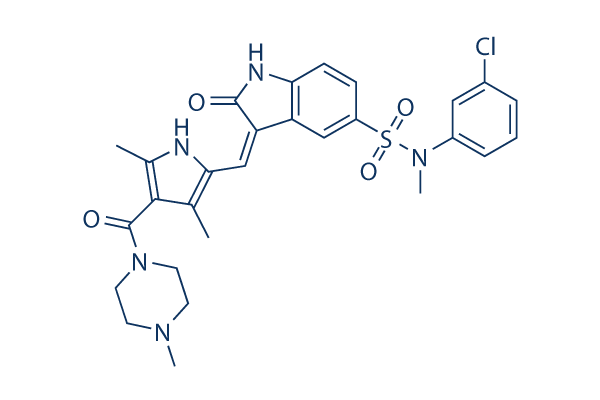
Chemical Structure
Molecular Weight: 568.09
Purity & Quality Control
Batch:
Purity:
99.73%
99.73
Related Products
| Related Products | SGX-523 Foretinib PHA-665752 BMS-777607 JNJ-38877605 Tivantinib PF-04217903 Tepotinib Savolitinib (AZD6094) MGCD-265 analog Golvatinib (E7050) Merestinib (LY2801653) MK-2461 NPS-1034 AMG 337 Sodium L-ascorbyl-2-phosphate NVP-BVU972 BMS-794833 S49076 | Click to Expand |
|---|---|---|
| Related Compound Libraries | Kinase Inhibitor Library Tyrosine Kinase Inhibitor Library PI3K/Akt Inhibitor Library Cell Cycle compound library Angiogenesis Related compound Library | Click to Expand |
Signaling Pathway
Cell Culture and Working Concentration
| Cell Lines | Assay Type | Concentration | Incubation Time | Formulation | Activity Description | PMID |
|---|---|---|---|---|---|---|
| A549 cells | Function assay | Inhibition of human recombinant c-MET kinase in A549 cells assessed as inhibition of HGF-induced cell growth, IC50=0.01 μM | ||||
| human MDCK cells | Function assay | 24 h | Inhibition of Met-mediated scattering in HGF-stimulated human MDCK cells pre-incubated overnight prior to HGF stimulation for 24 hrs measured after 24 to 48 hrs, IC50=0.152 μM | |||
| mouse BAF3 cells | Proliferation assay | 72 h | Antiproliferative activity against mouse BAF3 cells expressing TPR-Met after 72 hrs in absence of IL-3, IC50=0.53 μM | |||
| human SNU5 cells | Proliferation assay | 72 h | Antiproliferative activity against human SNU5 cells after 72 hrs, IC50=0.8 μM | |||
| human MKN45 cells | Proliferation assay | 72 h | Antiproliferative activity against human MKN45 cells after 72 hrs, IC50=1.3 μM | |||
| human HepG2 cells | Function assay | Inhibition of Met-mediated tumorigenesis in HGF-stimulated human HepG2 cells assessed as impairment in anchorage-independent growth by soft agar growth assay, IC50=1.561 μM | ||||
| mouse NIH/3T3 cells | Proliferation assay | 72 h | Antiproliferative activity against mouse NIH/3T3 cells expressing TPR-Met after 72 hrs, IC50=2 μM | |||
| human MCF7 cells | Proliferation assay | 72 h | Antiproliferative activity against human MCF7 cells after 72 hrs, IC50=6.2 μM | |||
| human SNU1 cells | Proliferation assay | 72 h | Antiproliferative activity against human SNU1 cells after 72 hrs, IC50=7 μM | |||
| human NCI-H1993 cells | Proliferation assay | 72 h | Antiproliferative activity against human NCI-H1993 cells after 72 hrs, IC50=7.3 μM | |||
| human MDA-MB-231 cells | Proliferation assay | 72 h | Antiproliferative activity against human MDA-MB-231 cells after 72 hrs | |||
| human NCI-H441 cells | Proliferation assay | 72 h | Antiproliferative activity against human NCI-H441 cells after 72 hrs | |||
| human BxPC3 cells | Proliferation assay | 72 h | Antiproliferative activity against human BxPC3 cells after 72 hrs | |||
| DLD1 cells | Function assay | 2.5 μM | Inhibition of human p38-alpha phosphorylation in DLD1 cells at 2.5 μM | |||
| DLD1 cells | Function assay | 2.5 μM | 16 h | Inhibition of human MET receptor in DLD1 cells at 2.5 uM after 16 hrs by Western blot | ||
| Click to View More Cell Line Experimental Data | ||||||
Mechanism of Action
| Targets |
|
|---|
In vitro |
||||
| In vitro | SU11274 exhibits greater than 50-fold selectivity for Met versus Flk and more than 500 times selectivity versus other tyrosine kinases such as FGFR-1, c-src, PDGFbR, and EGFR. This compound inhibits the phosphorylation of key regulators of the PI3K pathway, including AKT, FKHR, or GSK3β. Treatment with this chemical inhibits the growth of TPR-MET-transformed BaF3 cells in a dose-dependent manner with IC50 of <3 μM in the absence of interleukin 3, without growth inhibition of BaF3 cells transformed by other oncogenic tyrosine kinases, including BCR-ABL, TEL-JAK2, TEL-ABL, and TEL-PDGFβR. In addition to cell growth, this compound treatment significantly inhibits the migration of BaF3. TPR-MET cells by 44.8% and 80% at 1 μM and 5 μM, respectively. It inhibits HGF-dependent phosphorylation of Met as well as HGF-dependent cell proliferation and motility with an IC50 of 1-1.5 μM. In H69 and H345 cells which have functional Met receptor, this inhibitor inhibits the HGF-induced cell growth with IC50 of 3.4 μM and 6.5 μM, respectively. It induces G1 cell cycle arrest with cells in G1 phase increased from 42.4% to 70.6% at 5 μM, and induces caspase-dependent apoptosis by 24% at 1 μM. [2] This compound inhibits cell viability in c-Met-expressing non-small cell lung cancer (NSCLC) cells with IC50 values of 0.8-4.4 μM, and abrogates hepatocyte growth factor-induced phosphorylation of c-Met and its downstream signaling. [3] | |||
|---|---|---|---|---|
| Kinase Assay | In vitro Met kinase assay | |||
| A chimeric protein is constructed containing the cytoplasmic domain of human c-Met fused to Glutathione S-transferase (GST) and expressed in SF9 cells. The c-Met kinase GST-fusion protein is used for an ELISA-based Met biochemical assay using the random copolymer poly(Glu:Tyr) (4:1) immobilized on microtiter plates as a substrate. IC50 value is determined with various concentrations of SU11274 in a buffer containing 5 μM ATP and 10 mM MnCl2, 50 mM HEPES (pH 7.5), 25 mM NaCl, 0.01% BSA, and 0.1 mM Na orthovanadate. The kinase reaction is performed for 5 minutes at room temperature. The extent of substrate phosphorylation is measured using horseradish peroxidase-conjugated anti-pTyr antibodies. | ||||
| Cell Research | Cell lines | BaF3.TPR-MET, H69 and H345 cells | ||
| Concentrations | Dissolved in DMSO, final concentrations ~10 μM | |||
| Incubation Time | 24, 48, and 72 hours | |||
| Method | Cells are exposed to various concentrations of SU11274 in the presence or absence of HGF for 24, 48, and 72 hours. The number of viable cells is determined using the MTT assay or trypan blue exclusion. Cell Cycle and apoptosis are measured by fluorescence-activated cell sorter analysis via propidium iodide staining and Annexin V-positive staining, respectively. | |||
| Experimental Result Images | Methods | Biomarkers | Images | PMID |
| Growth inhibition assay | Cell viability |
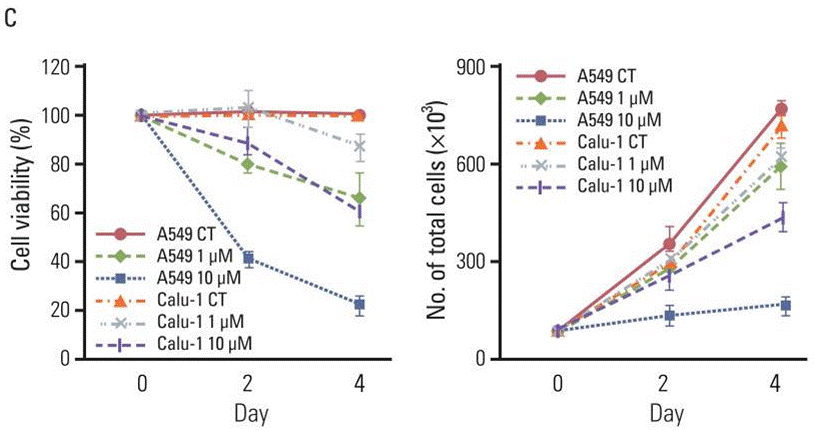
|
23341789 | |
| Western blot | p-Met / Met / p-AKT / AKT / p-ERK / ERK PUMA / Bcl-2 / Bax |
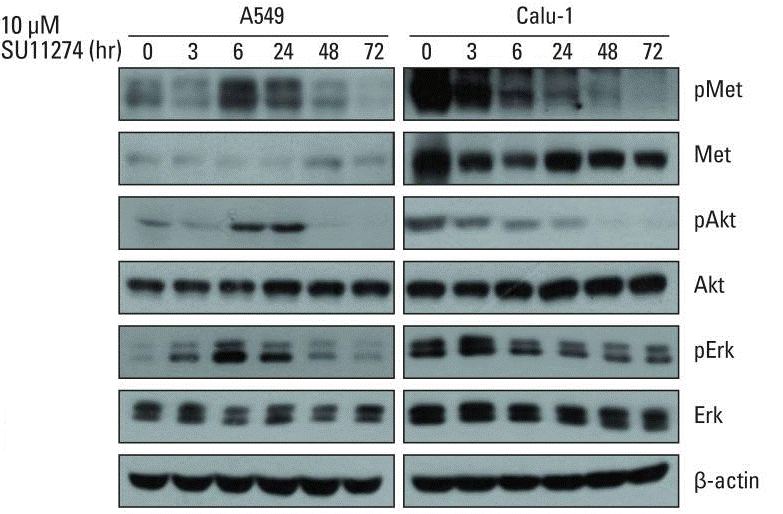
|
23341789 | |
| Immunofluorescence | p-SphK1 |
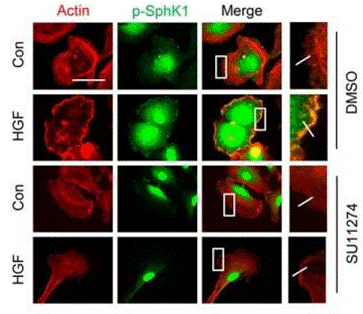
|
27864331 | |
References |
|
Chemical Information
| Molecular Weight | 568.09 | Formula | C28H30CIN5O4S |
| CAS No. | 658084-23-2 | SDF | Download SDF |
| Synonyms | PKI-SU11274 | ||
| Smiles | CC1=C(NC(=C1C(=O)N2CCN(CC2)C)C)C=C3C4=C(C=CC(=C4)S(=O)(=O)N(C)C5=CC(=CC=C5)Cl)NC3=O | ||
Storage and Stability
| Storage (From the date of receipt) | |||
|
In vitro |
DMSO : 92 mg/mL ( (161.94 mM) Moisture-absorbing DMSO reduces solubility. Please use fresh DMSO.) Ethanol : 2 mg/mL Water : Insoluble |
Molecular Weight Calculator |
|
In vivo Add solvents to the product individually and in order. |
In vivo Formulation Calculator |
|||||
Preparing Stock Solutions
Molarity Calculator
In vivo Formulation Calculator (Clear solution)
Step 1: Enter information below (Recommended: An additional animal making an allowance for loss during the experiment)
mg/kg
g
μL
Step 2: Enter the in vivo formulation (This is only the calculator, not formulation. Please contact us first if there is no in vivo formulation at the solubility Section.)
% DMSO
%
% Tween 80
% ddH2O
%DMSO
%
Calculation results:
Working concentration: mg/ml;
Method for preparing DMSO master liquid: mg drug pre-dissolved in μL DMSO ( Master liquid concentration mg/mL, Please contact us first if the concentration exceeds the DMSO solubility of the batch of drug. )
Method for preparing in vivo formulation: Take μL DMSO master liquid, next addμL PEG300, mix and clarify, next addμL Tween 80, mix and clarify, next add μL ddH2O, mix and clarify.
Method for preparing in vivo formulation: Take μL DMSO master liquid, next add μL Corn oil, mix and clarify.
Note: 1. Please make sure the liquid is clear before adding the next solvent.
2. Be sure to add the solvent(s) in order. You must ensure that the solution obtained, in the previous addition, is a clear solution before proceeding to add the next solvent. Physical methods such
as vortex, ultrasound or hot water bath can be used to aid dissolving.
Tech Support
Answers to questions you may have can be found in the inhibitor handling instructions. Topics include how to prepare stock solutions, how to store inhibitors, and issues that need special attention for cell-based assays and animal experiments.
Tel: +1-832-582-8158 Ext:3
If you have any other enquiries, please leave a message.
* Indicates a Required Field
Frequently Asked Questions
Question 1:
What is the solubility of S1080 SU11274 in acetone?
Answer:
The solubility of S1080 SU11274 in acetone is 7 mg/mL.






































